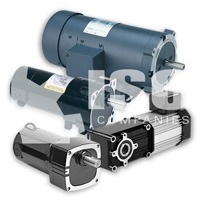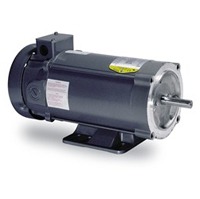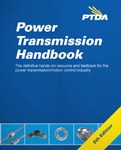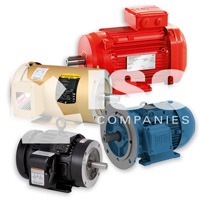 DC Motors
DC Motors
ISC Companies and affiliate Adams-ISC are distributors of mechanical power transmission parts including DC motors. For more information about the brands we offer and/or pricing, please contact us by phone 763-559-0033, by email [email protected], or by filling out our online contact form.
DC motors use direct current, which does not change directions and always moves in the same direction. The direction of flow is determined by the polarity of the source. DC is provided by changing abundant AC power into DC power through controllers that use electronic circuits called silicon-controlled full-wave rectifiers (SCRs). They are more complex, more costly, and require more maintenance than AC motors, but DC motors can operate at adjustable speeds when connected to simple controllers. There are two basic types: brush-type (brushed) and brushless.
Enclosures
DC Motors are supplied in different enclosure types, each providing a different level of cooling and mechanical protection. Enclosure types include DPG (drip proof, guarded), DPFG (drip proof, fully guarded), DPBV (drip proof, blower ventilated), TENV (totally enclosed, non-ventilated), and TEFC (totally enclosed, fan cooled).
 Brushed (Brush-Type)
Brushed (Brush-Type)
Brushed DC electric motors generate torque from DC power supplied by using internal commutation, stationary magnets, and rotating electrical magnets. The two types are permanent magnet and wound field. Brush-type DC motors should always run at the rated horsepower/torque. Running the motor under- or over-loaded shortens brush life.
Construction
- Stator (magnets): A magnetic field is generated by permanent magnets or electromagnetic windings.
- Rotor (armature): Made up of one or more windings that are energized, producing a magnetic field. The magnetic poles are attracted to the opposite poles generated by the stator, causing the rotor to turn. The switching of the field in the rotor windings is called commutation.
- Brushes: Brushed motors do not require a controller to switch current in the windings. Commutation is done mechanically. A copper sleeve (commutator) resides on the axle. As the motor turns, carbon brushes slide over the commutator. A dynamic magnetic field is generated inside the motor when voltage is applied across the brushes of the motor.
Advantages
- Cheapest and simplest motor
- Speed is linear to applied voltage
- Simple motor control
- High starting torque
Disadvantages
- High maintenance (commutator and brushes)
- Short life (due to physical wear)
- Electrically noisy
- Brushes can create friction and sparks
Permanent Magnet (PMDC) Brushed
PMDC, the most commonly used brushed DC motor type, have permanent magnets that produce the stator field. The rotating armature is made up of steel laminations with slots that hold copper windings, which are attached to a copper cylinder called the commutator. They respond to changes in voltage quickly because the stator field is always constant.
Wound Field Brushed
The magnetic field for brush-type wound-field DC motors is produced by wire-wound poles on the stator. Current passing through the windings produces the magnetic field. The armature is similar to that on a permanent magnet motor. There are three types of wound-field DC motors, which define the technique used for producing the magnetic field: series-wound, shunt-wound, and compound and stabilized shunt-wound.
Series-Wound (SWDC) Brushed
The field winding connects in series with the armature winding. They are ideally suited for high-torque applications. Motor speed varies widely with a change of load, which causes the motor to overspeed when unloaded. Applications include metal rolling and traction drives.
Shunt-Wound (SHWDC) Brushed
The motor field winding is connected in the shunt, or parallel, with the armature. Motor speed remains constant through normal load range. They may overspeed upon loss of shunt field power. Speed is adjusted by varying applied voltage to the armature. For applications requiring five or more horsepower.
Compound-Wound (CWDC) and Stabilized Shunt-Wound Brushed
CWDC motors use both a series and a shunt field. Speed characteristic varies little with load, while having the ability to increase torque when heavily loaded. They have higher torque than shunt-wound and offer better speed control than series-wound. Applications include elevators and cranes.
Brushless
Brushless DC motors also use permanent magnets, but they are mounted on the rotor and the windings are in the stator. Brushless motors do not have a commutator or brushes. They can deliver rated torque at higher speeds than corresponding permanent magnet motors.
Advantages
- High efficiency
- High speed operation
- Low maintenance
- Long life
- High output power to frame size ratio
Disadvantages
- Complicated motor control
- Large initial cost
- Need for commuting device (encoder or controller)
Top Brands We Offer
 Content on this page was created using excerpts from the Power Transmission Handbook (5th Edition), which is written and sold by the Power Transmission Distributor’s Association (PTDA).
Content on this page was created using excerpts from the Power Transmission Handbook (5th Edition), which is written and sold by the Power Transmission Distributor’s Association (PTDA).













You must be logged in to post a comment.